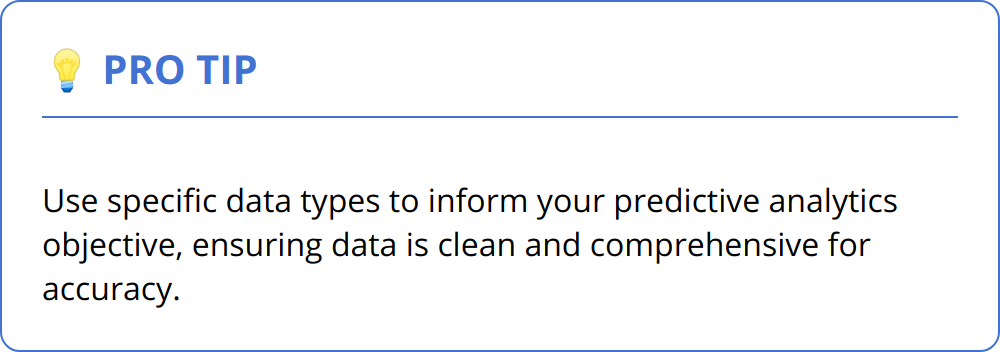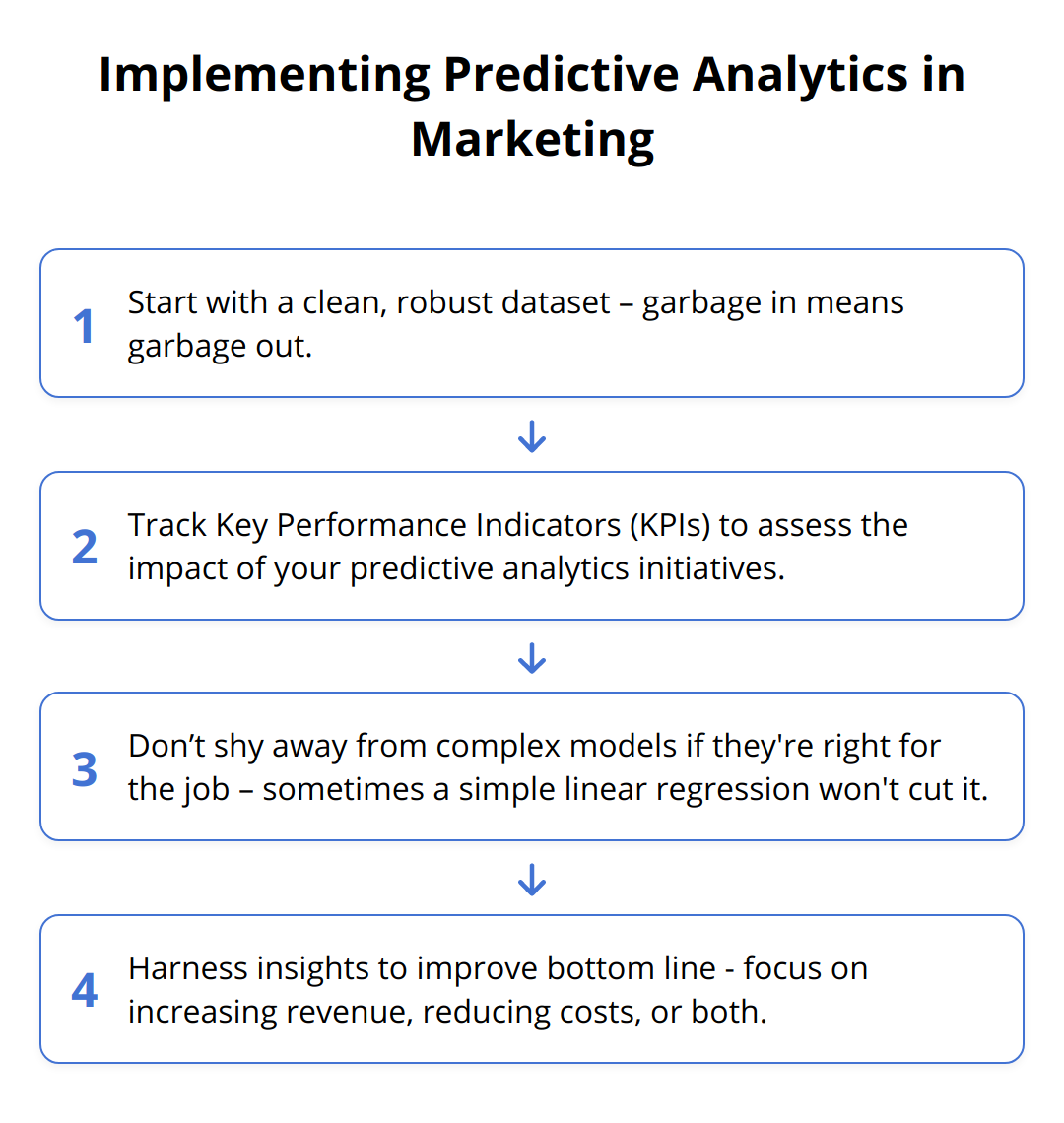Welcome to the beginner’s guide to harnessing the power of predictive analytics in marketing. We at Emplibot understand that navigating through data-driven strategies can be a game-changer for businesses aiming to enhance their market presence.
Embarking on the journey of predictive analytics means embracing technology to forecast trends, understand customer behaviors, and make informed decisions that can significantly impact your company’s growth. Get ready to discover how this sophisticated approach can transform your marketing outcomes and drive success.
Inhalt
ToggleHarnessing Predictive Analytics
Predictive analytics stands at the forefront of modern marketing, providing an unprecedented ability to forecast future customer behaviors and market trends. By processing vast amounts of data, predictive analytics empowers marketers to anticipate what customers will want or do next, allowing for highly strategic decision-making.
Machine Learning’s Role in Marketing
Machine learning is the engine behind predictive analytics, propelling marketing from reactive to proactive. Through its algorithms, machine learning sifts through data to find patterns and learn from them, enabling the automation of predictive insights. The more data fed into these systems, the smarter and more accurate the predictions become. Marketers using machine learning can adapt their strategies in real time, aligning with evolving consumer needs.

Data Types in Predictive Marketing
Understanding the data utilized in predictive analytics is fundamental for a marketer. Here’s what’s commonly used:
-
Historical Sales Data: This shows past customer behavior and is vital for trend analysis.
-
Customer Interaction Data: Everything from website visits to contact center calls, giving a picture of consumer engagement.
-
Social Media Activity: Reflects brand perceptions and can indicate emerging trends.
-
Market Research: Provides a broader landscape of industry movements.
Applying these data types to predictive models can lead to actionable marketing strategies. For example:
-
Personalization: By anticipating individual consumer preferences, marketers can tailor experiences to increase engagement and sales conversions.
-
Customer Retention: Predict which customers might churn and why, then implement targeted retention strategies.
-
Demand Forecasting: Anticipate product demand to optimize inventory and pricing strategies.

A practical step is to start with a clear objective like improving customer retention and then collecting the specific data types that can inform that goal. Ensure that your data is clean and comprehensive for the most accurate predictions.
For marketers beginning their journey with predictive analytics, consider these practical steps:
-
Identify key business questions predictive analytics can answer.
-
Gather diverse and relevant data sources.
-
Choose the right predictive analytics tools.
-
Continuously test, learn from, and improve your models.
Tapping into predictive analytics isn’t just about employing data science; it’s about integrating insights into your marketing strategy. With each prediction, you’re not just seeing into the future; you’re actively shaping it.
How Does Predictive Analytics Benefit Marketing?
Predictive analytics is a transformative tool in the marketing toolkit, unlocking the power to sculpt customer journeys and hone marketing campaigns with precision. By leveraging predictive analytics, marketing professionals can significantly enhance customer experience, optimize campaigns for better results, and ultimately boost sales and profitability.
Better Customer Experience Through Anticipation
Customers today expect personalization. They want services and products tailored to their preferences, and predictive analytics is the magic wand that makes this possible. With data-driven insights gathered from user interactions, businesses can predict what customers want before they even ask for it. For instance, Netflix’s recommendation engine is a great example of predictive analytics in action, keeping subscribers glued to their screens by suggesting content they are likely to enjoy.
Moreover, predictive analytics helps identify potential issues on customer journeys before they become roadblocks. By proactively addressing these, businesses ensure client satisfaction and loyalty, laying the foundation for a seamless experience that keeps clients coming back.

Driving Campaign Success
Campaign optimization is another field where predictive analytics shines. By analyzing past campaign data, marketers can identify which strategies resonated most with their audiences and which didn’t. This foresight allows for resource allocation to high-performing channels and tactics. For example, if data shows email campaigns see higher engagement than social media, resources can be shifted to email marketing automation to increase efficiency and returns.
Predictive analytics also equips marketers to anticipate trends, giving the ability to create content that meets the moment, consequently increasing campaign relevancy and engagement. In fact, firms leveraging advanced analytics can achieve up to 8.5 times the ROI for their marketing spend, as reported by McKinsey & Company.

Sales and Profitability Growth
At its core, the end goal of marketing is to drive sales and profitability. Here, predictive analytics is invaluable. By forecasting demand, businesses can adjust their inventory accordingly, reducing overstock or stockouts, which directly impacts the bottom line. Imagine the advantage of knowing which products will see a spike in sales during a seasonal period and stocking up in advance.
In the realm of profitability, predictive analytics allows for more sophisticated pricing strategies. Dynamic pricing models, which adjust prices based on predicted demand, have been used effectively by industries such as travel and e-commerce to improve margins. Take the airline industry: dynamic pricing based on predictive models has been a cornerstone for years, maximizing profits for each flight.
When diving into the world of predictive analytics, here are a few actionable steps for marketers:
-
Extract and utilize customer feedback and support interactions to refine customer profiles.
-
Analyze conversion paths to identify the most effective touchpoints for engagement.
-
Use A/B testing to validate predictive model suggestions and improve campaign effectiveness.
Predictive analytics is much more than a buzzword; it’s a robust pathway to creating relevant, profitable marketing strategies that resonate with customers on a personal level. It’s a strategic pivot that turns hindsight into foresight, fueling data-driven decisions that propel businesses forward. As companies gain mastery over these analytics, the marketing sphere will witness a new era of personalized, efficient, and profitable campaigns.
Refining Marketing with Predictive Techniques
Tapping into the right analytical techniques boosts the precision of your marketing efforts. Successful marketers know that different predictive analytics techniques offer unique insights and advantages. Here’s how you can apply them to ramp up your marketing game.
Regression Analysis for Revenue Growth
When it comes to predicting customer spending, regression analysis is a powerhouse. It’s not just about forecasting sales; it’s about connecting the dots between customer actions and their wallets. By analyzing historical buying patterns against various customer attributes, regression models can forecast future spending behavior. Armed with this insight, tailor your marketing efforts to focus on high-value customers or up-selling opportunities.
Pinpoint Customers at Risk of Churning
No marketer wants to see customers slip away. Classification models are essential here because they help you spotlight the warning signs of customer churn. Think of it as creating a customer loyalty radar – by examining customer interaction data, you can predict which customers are likely to churn and why. Once these customers are identified, it’s time for swift, targeted retention campaigns to keep them in the fold.
Segmentation for Precision Targeting
Clustering casts segmentation in a whole new light, letting marketers group customers by shared characteristics. This is not the spray and pray of old school marketing – it’s precision targeting. By clustering similar customer profiles, create highly customized marketing messages that resonate. This elevates customer engagement and drives conversions since personalization is the name of the game.

For those ready to bring these analytical strategies into their marketing plan, opt for tools that simplify the process. Harness these insights and watch as your marketing campaigns become more efficient and effective than ever.
Implementing Predictive Analytics
Stepping into the realm of predictive analytics can seem daunting, but a tactical approach can make this transition seamless for your marketing strategy. Initiating small with a specific aim allows your marketing team to understand the complexities of data without becoming overwhelmed and establishes a foundation for scaling analytics practices in the future.
Start Specifically and Scale Sensibly
Embarking on predictive analytics does not require a monumental overhaul of your current marketing strategy. In fact, it’s best to start with one specific, measurable goal that aligns with your broader business objectives. It might be to reduce customer churn by 5% or increase upsell opportunities within a quarter. By focusing on one clear objective, you can measure the impact of predictive analytics directly against your goals, which serves as a definitive metric for success or a signpost for strategy adjustment.
Tool Selection: A Balanced Merge of Power and Usability
Choosing the right tools is pivotal for achieving a successful predictive analytics initiative. Seek out tools that offer a balance between advanced capabilities and user-friendly interfaces. For many marketers, the integration of robust yet accessible platforms, such as those offering plugins with CRM systems, provides both the depth of analytics needed and the simplicity for practical application. This ensures that team members of varying analytical skill levels can contribute to and benefit from predictive insights.
The Path to Perfection: Continuous Refinement
Predictive models are not set-and-forget systems; they require ongoing attention and adjustment to maintain accuracy. Numerous factors, including changes in market conditions, consumer behavior shifts, and the introduction of new products or services, can all affect the relevance of your predictive models.
Here are some actionable steps to ensure your predictive analytics remain sharp:
-
Regularly review the performance of your predictive models against real-world outcomes.
-
Adjust your models as new data becomes available or when business goals shift.
-
Encourage feedback from various departments within your organization that may interact with predictive analytics results, such as sales or customer service teams.
-
Opt for tools that facilitate easy adjustments to models without the need for extensive IT intervention.
Moving predictive analytics from theory to practice requires a thoughtful approach tailored to your unique business needs. It’s a blend of strategic planning, smart tool selection, and a commitment to ongoing optimization that will solidify predictive analytics as a valuable asset in your marketing arsenal. With dedication to these principles, your marketing team can leverage predictive analytics to inform strategy, inspire action, and invigorate growth.
Wrapping Up
Predictive analytics stands as a transformative force in marketing, driven by data and innovative machine learning techniques. Marketers now have the power to anticipate consumer needs, tailor campaigns for maximum effectiveness, and drive tangible business growth through informed decision-making.
![Key Takeaways - Predictive Analytics Marketing [Beginner's Guide]](https://emplibot.com/wp-content/uploads/2023/12/Predictive-Analytics-Marketing-Beginners-Guide-6-2023-12-19-071007.9138220000.png)
The intersection of data analysis and marketing strategy is where predictive analytics shines, offering a rich tapestry of opportunities to expand customer reach and enhance engagement. It’s a landscape ripe with potential for businesses keen on staying ahead of the curve. Marketers equipped with insights gained from predictive models can craft personalized experiences that resonate with their audience, solidify customer loyalty, and outpace competitors.
Getting started with predictive analytics requires a mindful strategic approach:
-
Set specific goals to align predictive analytics with your business objectives
-
Gather relevant and diverse data to train your models
-
Choose intuitive tools that support your marketing endeavors
-
Continuously refine your models to reflect the dynamic market
For businesses ready to adopt data-driven strategies but looking for a seamless way to maintain a dynamic online presence, Emplibot offers a tailored solution. We seamlessly publish SEO-friendly articles on your WordPress site, ensuring your blog stays updated with minimal effort on your part.
Embrace the power of data-driven decision-making with predictive analytics to:
-
Boost campaign efficiency and ROI
-
Heighten customer satisfaction and experience
-
Drive sales and enhance profitability
In the landscape of modern marketing, where data is abundant and consumer expectations constantly evolve, predictive analytics serves as a beacon, guiding brands toward more mindful and profitable engagement with their customers. It’s not futuristic—it’s here, and for marketers who recognize its value, it’s an indispensable part of the toolkit.
Ultimately, predictive analytics is about foresight and smart marketing choices. It’s a journey towards more strategic and profitable marketing actions, a commitment to better results, and an amplified understanding of your customer base. By stepping into the predictive analytics space, you open doors to a new era of marketing precision.
To learn more about Emplibot and how it can streamline your content strategy, visit us.











